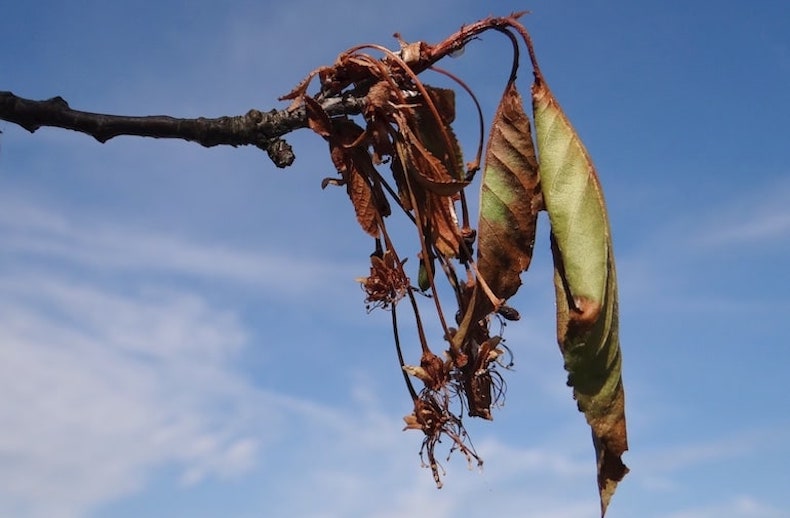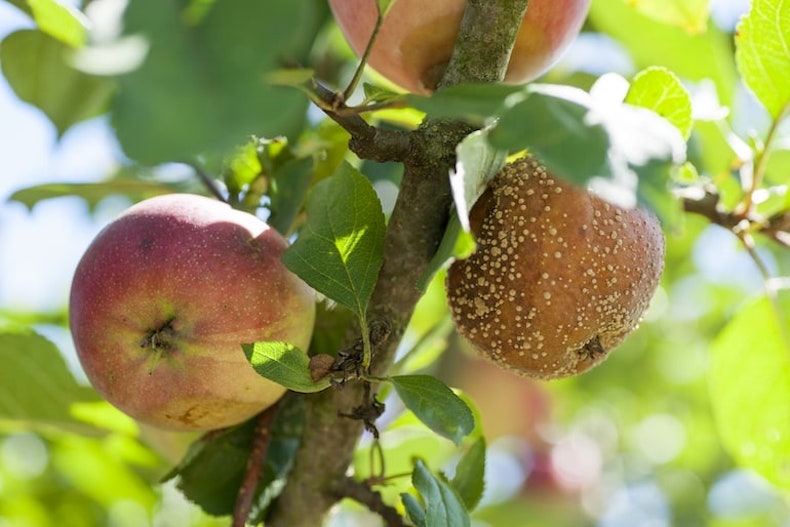Garden diseases - Blossom wilt

Blossom wilt can severely damage your fruit trees
Image: Jerzy Opioła, CC BY-SA 4.0, via Wikimedia Commons
A nasty fungal disease which affects a variety of fruit trees and with one strain which specifically attacks apple trees, blossom wilt is a real nuisance. But by acting promptly, you’ll minimise the damage it does and give yourself the best chance of avoiding reinfection next year.
What is blossom wilt?
Blossom wilt is caused by two closely related fungi – Monilinia laxa and M. fructigena, with a third strain, M. laxa f. sp. Mali, which only attacks apple trees. It’s a common infection which affects apples, pears, cherries, plums and many more fruit and ornamental trees. The disease spreads by entering wounds in the tree and fruit – it’s often damage done by birds that makes trees vulnerable.
It’s called blossom wilt because the first signs of infection usually show up during the spring when you’ll notice the blossom and fresh leaves on fruiting spurs begin to wither and turn brown. Left undealt-with, the infection spreads to other parts of the tree, and to developing fruit, which turns brown as it rots – a condition called ‘brown rot’.
How to deal with blossom wilt

Left unattended, blossom wilt can lead to brown rot
Image: Vilor/Shutterstock
Like all fungi, blossom wilt thrives in wet conditions and the likelihood and severity of infection varies with the weather. A damp spring and early summer make blossom wilt and brown rot much more likely.
The sooner you attack the infection, the better – keep a close eye on your trees during the spring, and deal with this problem before it takes a hold. If possible, prune out infected branches and burn, also removing fruit showing signs of brown rot and disposing of it.
Get rid of affected material as soon as you can. You may notice light brown pustules covering infected fruit – don’t leave it hanging around because it will spread to unaffected fruit. Also remove any rotten fruit still hanging from the tree during the autumn as these hold spores that reinfect the tree the following spring.
How to prevent blossom wilt

Keep on top of pruning to minimise this fungus from developing
Image: XIE WENHUI/Shutterstock
Good tree hygiene is a must for preventing all sorts of plant diseases. Rake up leaves during the autumn and, if your trees are infected, do remember to disinfect pruning tools like secateurs and saws before using them on another tree.
Do also make sure you prune your fruit trees regularly. By improving air circulation around branches, you help leaves and stems to dry quickly, denying the fungus the conditions it needs to establish itself.
Because bird damage can help the spread of blossom wilt, it might be possible to net smaller trees, although that does rather spoil the spectacle of spring blossom.
Don’t forget that brown rot affects stored fruit too – if you’re keeping apples or pears, put them in a cool, dark, slightly humid place with plenty of air flow, place them so that they’re not touching and check regularly.
Other pages you might like
See all pests & diseases guides
Individual guides
Diseases
- Apple scab
- Bacterial canker
- Blackleg
- Botrytis
- Brown rot
- Clematis wilt
- Downy mildew
- Fungal disease
- Honey fungus
- Leaf scorch
- Leaf spot
- Leek rust
- Lily disease
- Peach leaf curl
- Pear rust
- Phytophthora root rot
- Potato & tomato blight
- Powdery mildew
- Silver leaf fungus
- Tomato greenback
- Tomato leaf curl
- Tomato stem canker







